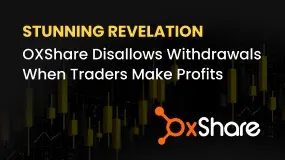简体中文
繁體中文
English
Pусский
日本語
ภาษาไทย
Tiếng Việt
Bahasa Indonesia
Español
हिन्दी
Filippiiniläinen
Français
Deutsch
Português
Türkçe
한국어
العربية
What Bond Yields Are Saying About the Global Economy?
Abstract:In a world increasingly driven by sentiment and speculation, few instruments offer a more sober and forward-looking perspective than bonds. Often overlooked by retail investors and sensationalist headlines, the bond market operates as a quiet but powerful barometer of economic expectations.

While investors may have been optimistic that last months financial market instability had passed, renewed fluctuations in U.S. Treasury yields indicate that market unease persists.
On Monday, the yield on long-term U.S. government bonds briefly climbed above 5%, marking its highest point since October 2023, before easing slightly.
This development came in the wake of Moody‘s decision on Friday to revise its outlook on the U.S. government’s credit rating, pointing to a decade-long rise in federal debt as a key concern.
At the same time, U.S. lawmakers are moving forward with a fiscal package that is expected to significantly expand the federal debt load, which currently stands at $36 trillion.

In a world increasingly driven by sentiment and speculation, few instruments offer a more sober and forward-looking perspective than bonds. Often overlooked by retail investors and sensationalist headlines, the bond market operates as a quiet but powerful barometer of economic expectations. From central bank policy to inflation forecasts and recession risks, yields and curves offer deep insights into where we are and where we might be headed.
At the heart of this narrative is the relationship between bond yields and interest rates. Government bonds, especially those issued by developed economies such as the United States, the United Kingdom, and Germany, are viewed as among the safest assets globally. The yields on these instruments are not merely reflective of the cost of borrowing, but they encapsulate investor sentiment, inflation expectations, and anticipated central bank actions.
Perhaps the most widely discussed phenomenon in recent times has been the inverted yield curve, that is, when long-term yields fall below short-term yields. In typical economic conditions, longer-term debt commands a higher yield, compensating investors for inflation risk and the time value of money. But an inversion suggests markets believe interest rates are set to fall, often due to an impending economic slowdown. Historically, such inversions have been reliable, albeit not immediate, predictors of recessions.
The bond market also offers real-time feedback on central bank policy. Consider the Bank of Englands struggle with sticky inflation. While policymakers may raise interest rates to combat price increases, falling yields on long-dated gilts can indicate that investors believe inflation will eventually be tamed or that aggressive tightening may overcorrect, leading to economic contraction.
Globally, the recent trend of falling yields despite relatively high policy rates is noteworthy. This may indicate a market consensus that rate hikes have peaked or that growth is expected to soften. Moreover, in economies where yields remain stubbornly high, such as emerging markets, investors may demand a premium for inflation risk, currency volatility, or political uncertainty.
Corporate bond spreads, another key metric, shed light on credit risk and business confidence. When spreads widen significantly over government bonds, it suggests rising concern about defaults or deteriorating economic conditions. Conversely, narrowing spreads are generally associated with improving risk appetite and economic optimism.
In essence, bonds act as the connective tissue between macroeconomic fundamentals and financial market expectations. Unlike equities, which can be swayed by corporate performance or investor hype, the bond market tends to focus on the long game, which includes growth, inflation, and monetary stability.
For traders, analysts, and policymakers alike, ignoring the signals emanating from the bond market comes at a cost. As the world continues to grapple with inflation volatility, geopolitical uncertainty, and shifting monetary regimes, the message from bonds may not always be loud, but it is often prophetic.

Disclaimer:
The views in this article only represent the author's personal views, and do not constitute investment advice on this platform. This platform does not guarantee the accuracy, completeness and timeliness of the information in the article, and will not be liable for any loss caused by the use of or reliance on the information in the article.
Read more

Scam Alert: Know the Risky Side of InstaForex in India
you should always Scam Alert in forex market. If something seems too good to be true, it often hides red flags behind it. Therefore, We reviewed InstaForex and reveal hidden risks associated with it. Whether you are an Indian trader, a potential user, or an existing client, it is crucial to understand the risks associated with InstaForex .

Going to Invest in FXCL? Move Back to Avoid Scams & Losses
Are FXCL officials calling you to make you a customer by promising a magical profit number? Stop! These officials follow this route to onboard customers and make them deposit at regular intervals. However, when you wish to withdraw, the officials will deny your request. This is nothing but a strong indicator of a scam forex broker. In this article, we will expose the wrongdoings of this Botswana-based broker.

Stunning Revelation: OXShare Disallows Withdrawals When Traders Make Profits
The revelation that OXShare disallows withdrawals to traders when they make profits is stunning but true. Many traders have complained about it on forex broker review platforms, but to no avail. They may receive assurances, but company officials do not live up to their promises. What’s more, these officials manipulate trades, forge vital details, and eventually scam traders who put their hard-earned capital on it. In this article, we will expose OxShare with proof. Read on to check them.

WikiFX Broker Assessment Series | Windsor Brokers: Is It Trustworthy?
In this article, we will conduct a comprehensive examination of Windsor Brokers, delving into its key features, fees, safety measures, deposit and withdrawal options, trading platform, and customer service. WikiFX endeavours to provide you with the essential information required to make an informed decision about utilizing this platform.
WikiFX Broker
Latest News
Join WikiFX’s Agent Growth Event | Turn Your Success into a Global Achievement
Forex Trends Explained for Your Successful Trading Experience
Do Kwon Faces 130-Year Prison Sentence After Guilty Plea in $40B Crypto Collapse
Best 5 Low-Spread FX Brokers in India 2025
Major Pairs in Forex: Top Traded Currency Insights
What is ECN in Trading? A Simple Guide
SEC Settles California Trader with Over $234,000 Spoofing Scheme
What Is Forex Trading Fee? A Beginner’s Guide
Understanding UAE’s Financial Market Regulation: SCA and DFSA
Scam Alert: Know the Risky Side of InstaForex in India
Currency Calculator


